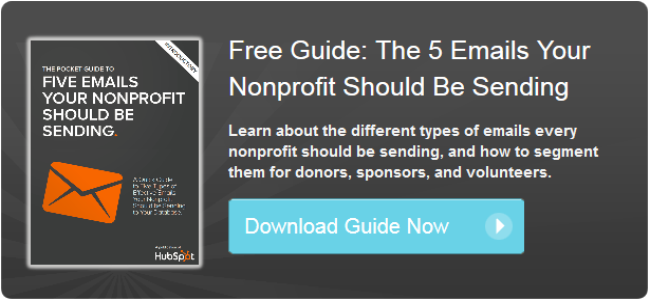 Having an efficient way to update and manage your donors in your organization’s database is directly aligned with your marketing and fundraising success. Your current constituents and prospective supporters are the basis for your organization's success and whom you'll be engaging with via email, social media, and even in person.
Having an efficient way to update and manage your donors in your organization’s database is directly aligned with your marketing and fundraising success. Your current constituents and prospective supporters are the basis for your organization's success and whom you'll be engaging with via email, social media, and even in person.
Whether you have a new executive director taking over the fundraising arm of your organization or a new marketer looking to engage previous donors, your database is the heart of our organization and has be taken care of and maintained.
Having a clean database can help your cause marketing.
The individuals you communicate with on a daily basis, whether they are donors, fundraisers, volunteers, or members, are just as important as your mission.
Being able to market to them consistently and in a strategic way can help increase your fundraising results in a matter of months.
Having a clean database can help your marketing and fundraising team in many ways.
It makes it easier to segment email lists.
This is important because the more target your messages are, the more likely an individual is going to engage and support your organization.
You don't want to send the same message to everyone (i.e. your volunteers need different information than your major donors), so you need to make it easy to create lists of different personas.
It allows you to target donors based on activity.
If you're consistently tracking the interactions of, donations made by, and events attended by individuals, you're able to target those who may want to donate to your cause. This also makes it easier to target event participants in different cities and states so they get information that is most relevant to them.
Sending a list of events that are all over the country is too much information to send to potential registrants, so segment contacts by city or state and send them specific event invites.
It helps you better engage individuals on social media.
If you're collecting social media information, like Twitter handles of your donors, you're able to interact with them online -- this could mean simply saying thank you or inviting them to an event. Doing so can make them feel really special, meaning they'd become much more likely to take action and share with their own social networks, which can attract new constituents to your organization.
It improves email deliverability rates.
No one likes spam. When you send messages to inactive email addresses, you're lowering your nonprofit's credibility online by spamming people that are no longer active. You want your email campaigns to have the highest deliverability rates so you are reaching active emails and complying with CAN-SPAM laws.
So, deleting emails that are older than 16 months will help to keep your email lists up to date and your deliverability high.
It helps you better report your data.
You want to be able to show what marketing efforts resulted in the most donations, participants, or fundraisers. But if you're not able to run reports on specific data, you won't be able to get an accurate picture of what's working and what's not.
You also run the risk of reporting inaccurately and spending marketing budget on the wrong channels when others are performing much better.
Here's how you can clean and maintain your donor database.
If there are too many people updating records or there is no clear definition of which fields mean what, it’s very hard to understand whom you should be engaging with online or in person.
You want to eliminate your duplicates, update blank record fields, and create documentation to manage your database, among other things so you can shift the focus on more important projects that will increase your fundraising year over year.
Here are several ways to clean up your database, as laid out by The Chronicle of Philanthropy.
Understand how your data will be used.
Whether it's from the perspective of the database manager, your development and fundraising teams, or future executive directors, you want to understand how all parties are using or will be using the database.
Consider standardizing donor information fields, including their donor status (i.e. new, recurring, major, etc.), contact information, donation amounts, and any other fields that are unique to your organization.
To easily report and manage individual records, create a unique identifier for each donor/contact record -- this can be a number or combination of numbers and letters.
Be sure to create consistent definitions.
Along with understanding your data, you want to make sure everyone understands the field definitions as well. The primary users should be aware of all the important fields, what they mean and how they should be used.
Set up a weekly or monthly meeting to go over any changes in the database with the primary users and make sure to share those changes with the rest of the team. If fields are no longer being used or are not relevant, hide them but don't delete the data. You may need it in the future.
Clean up records of your biggest and most engaged donors first.
Since these individuals will be the ones you rely on for a large part of your fundraising dollars, make sure their records are up to date and accurate.
Sort your database by dollars donated and work your way down the list. You can see who hasn’t given in over a year or has never given and reach out to them for your next campaign.
Anyone that hasn’t been active in the last 3 years should be considered dead and is worth deleting. Email addresses typically expire after 16 months, due to a change of job, so consider that as well.
Decide if you need an overhaul or just individual updates.
Overhauling your database and making large changes can do more harm than good sometimes. So, first decide if you need to change your database and update multiple fields and processes or if you just need to clean up a handful of records and/or fields.
Including another person to monitor the changes made allows for less error and redundancies. You may also need to consider custom fields for your major donors, so including someone from your development team or major gifts department is important.
If necessary, recruit volunteers to help you out.
If you don’t have the staff with the knowledge or time to dedicate to a database clean up, look for interns or volunteers to help. There are many individuals that have experience with databases that can help provide even more insight on how to be efficient with cleaning up and maintaining your data.
Make it clear that the task is tedious and detail oriented to attract the right help.
Consolidate your data into one place.
Maintaining data in one place is enough work. So, if you have multiple databases where you store information on your donors, consider consolidating them into one over time.
This can be a big task to accomplish but can save you a lot of time and minimize errors in the long run. It can also heavily reduce your costs of hosting data, which can be directed elsewhere.
Limit your staff’s access to your database.
While you should have one person monitor all changes made to your database and run consistent maintenance, you will need to limit the access or ability to make changes to different people on your staff.
Allow only a small group of people to have the ability to edit or delete fields and information, but allowing the rest of your staff to be able to view the data at anytime. You can create administrative roles in almost any donor database and it can really help avoid large errors or lose of data.
Clean up your data on a consistent basis.
Cleaning up your data needs to be a recurring activity to ensure that you’re actively engaging and nurturing the right people as well as eliminating those who are no longer going to give or support your organization. You can also generate reports on different metrics of your database to monitor its growth.
These responsibilities should lie with the person that has administrative access and is performing the majority of the updates and changes to your database.
Document everything for future reference.
Create a central location for your database manual and information log, including every change or update made, a list of definitions for each field, a list of people that are responsible for your database, and anything else from which you think future database managers or users would benefit.
Thinking of how those who work for the organization 5 to 10 years down the line will help you identify the most important information needed.
TechSoup offers a number of discounted donor databases as well as some more helpful resources to managing them.
How does your nonprofit keep all of its data regarding donors and fundraising efforts organized?





![I Mastered How to How to Create Meaningful Nonprofit Emails, Here Are All My Secrets [+ Nonprofit Newsletter Examples]](https://53.fs1.hubspotusercontent-na1.net/hubfs/53/nonprofit.jpg)


![A Quick Guide to Nonprofit Website Redesigns [+Best Practices]](https://www.hubspot.com/hubfs/nonprofit%20website%20redesign-1.jpg)


